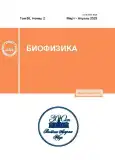Stability of collagen gel after uv irradiation
- 作者: Nashchekina Y.A1,2, Trusova N.A1, Nikonov P.O1, Nashchekin A.V2, Mikhailova N.A1
-
隶属关系:
- Institute of Cytology, Russian Academy of Sciences
- Ioffe Institute, Russian Academy of Sciences
- 期: 卷 68, 编号 2 (2023)
- 页面: 257-262
- 栏目: Articles
- URL: https://journals.rcsi.science/0006-3029/article/view/144424
- DOI: https://doi.org/10.31857/S0006302923020060
- EDN: https://elibrary.ru/CALMAF
- ID: 144424
如何引用文章
全文:
详细
作者简介
Yu. Nashchekina
Institute of Cytology, Russian Academy of Sciences;Ioffe Institute, Russian Academy of Sciences
Email: nashchekina.yu@mail.ru
St. Petersburg, Russia
N. Trusova
Institute of Cytology, Russian Academy of SciencesSt. Petersburg, Russia
P. Nikonov
Institute of Cytology, Russian Academy of SciencesSt. Petersburg, Russia
A. Nashchekin
Ioffe Institute, Russian Academy of Sciences
N. Mikhailova
Institute of Cytology, Russian Academy of SciencesSt. Petersburg, Russia
参考
- A. Bailey and R. Paul, J. Soc. Leather Technol. Chem., 82, 104 (1998).
- S. Ricard, Perspect. Biol., 1, 3 (2011).
- S. Ricard-Blum, Perspect. Biol., 3, 1 (2011).
- Yu. А. Nashchekina, А. А. Starostina, N. А. Trusova, et al., J. Physics: Conf. Series, 1697, 012053 (2020).
- A. Amaro-Ortiz, B. Yan, and J. A. D'Orazio, Molecules, 19, 6202 (2014).
- Yu. A. Nashchekina, N. M. Yudintceva, P. O. Nikonov, et al., Bull. Exp. Biol. Med., 163, 123 (2017).
- M. G. Haugh, C. M. Murphy, R. C. McKiernan, et al., Tissue. Eng. Part A, 17, 1201 (2011).
- Y. Hu, L. Liu, W. Dan, et al., Int. J. Biol. Macromol., 55, 221 (2013).
- S. J. Hollister and R. D. T. Maddox, J. Biomater., 23, 4095 (2002).
- J. S. Pieper, T. Hafmans, J. H. Veerkamp, et al. Biomaterials, 21, 581 (2000).
- M. G. Haugh., PhD Thesis (Trinity Colledge, Dublin University, Ireland, 2008).
- D.-H. Lew, P. H-T. Liu, and D. P. Orgill, J. Biomed. Mater. Res. B. Appl. Biomater., 82, 51 (2007).
- L. H. Olde Damink, P. J. Dijkstra, M. J. van Luyn, et al., Biomaterials, 17, 765 (1996).
- N. Davidenko, D. V. Bax, C. F. Schuster, et al., Mater. Sci.: Mater. Med., 27,14 (2016).
- N. Metreveli, L. Namicheishvili, K. Jariashvili, et al., Int. J. Photoenergy, 76830, 1 (2006).
- M. P. Ohan, K. S. Weadock, and M. G. Dunn, J. Biomed. Mater. Res., 60, 384 (2002).
- G. Chandrakasan, D. A. Torchia, K. A. Piez, J. Biol. Chem., 251, 6062 (1976).
- O. H. Lowry, N. J. Rosbrough, A. L. Farr, and R. J. Randall, J. Biol. Chem., 193, 265. (1951).
- Y. Nashchekina, A. Chabina, A. Nashchekin, et al., Polymers, 12, 1042 (2020).
- A. Sionkowska, J. Photoch. Photobiol. B: Biology, 82, 9 (2006).
- A. Kaminska and A. Sionkowska, Pol. Degr. Stability, 51,19 (1996).
补充文件









